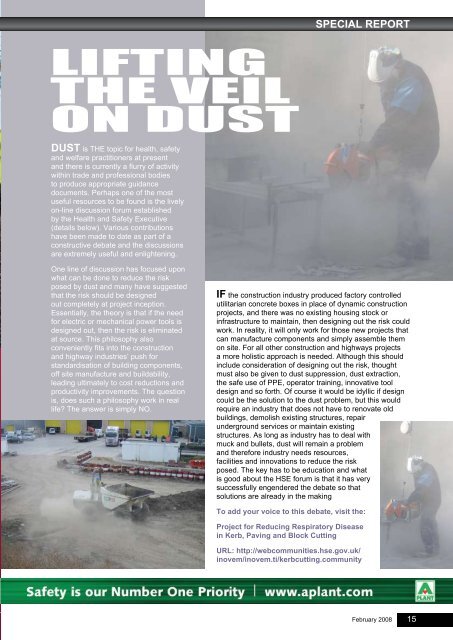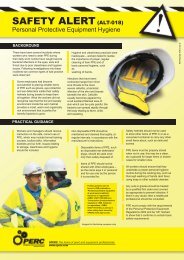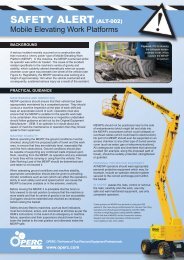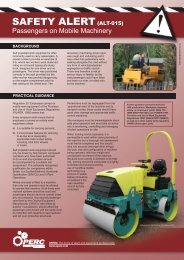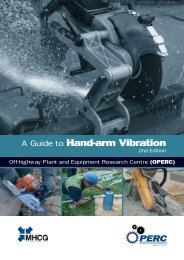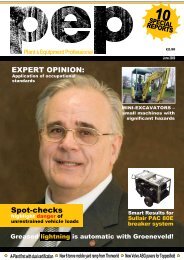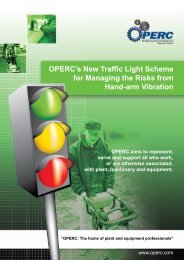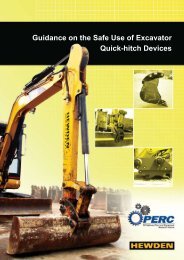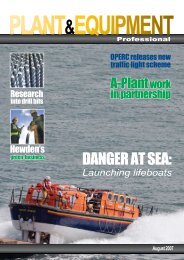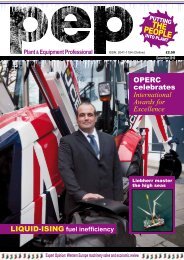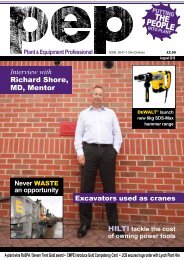Plant&Equipment
Download pdf - OPERC
Download pdf - OPERC
- No tags were found...
Create successful ePaper yourself
Turn your PDF publications into a flip-book with our unique Google optimized e-Paper software.
special report<br />
Lifting<br />
the veil<br />
on Dust<br />
Dust is THE topic for health, safety<br />
and welfare practitioners at present<br />
and there is currently a flurry of activity<br />
within trade and professional bodies<br />
to produce appropriate guidance<br />
documents. Perhaps one of the most<br />
useful resources to be found is the lively<br />
on-line discussion forum established<br />
by the Health and Safety Executive<br />
(details below). Various contributions<br />
have been made to date as part of a<br />
constructive debate and the discussions<br />
are extremely useful and enlightening.<br />
One line of discussion has focused upon<br />
what can be done to reduce the risk<br />
posed by dust and many have suggested<br />
that the risk should be designed<br />
out completely at project inception.<br />
Essentially, the theory is that if the need<br />
for electric or mechanical power tools is<br />
designed out, then the risk is eliminated<br />
at source. This philosophy also<br />
conveniently fits into the construction<br />
and highway industries’ push for<br />
standardisation of building components,<br />
off site manufacture and buildability,<br />
leading ultimately to cost reductions and<br />
productivity improvements. The question<br />
is, does such a philosophy work in real<br />
life? The answer is simply NO.<br />
If the construction industry produced factory controlled<br />
utilitarian concrete boxes in place of dynamic construction<br />
projects, and there was no existing housing stock or<br />
infrastructure to maintain, then designing out the risk could<br />
work. In reality, it will only work for those new projects that<br />
can manufacture components and simply assemble them<br />
on site. For all other construction and highways projects<br />
a more holistic approach is needed. Although this should<br />
include consideration of designing out the risk, thought<br />
must also be given to dust suppression, dust extraction,<br />
the safe use of PPE, operator training, innovative tool<br />
design and so forth. Of course it would be idyllic if design<br />
could be the solution to the dust problem, but this would<br />
require an industry that does not have to renovate old<br />
buildings, demolish existing structures, repair<br />
underground services or maintain existing<br />
structures. As long as industry has to deal with<br />
muck and bullets, dust will remain a problem<br />
and therefore industry needs resources,<br />
facilities and innovations to reduce the risk<br />
posed. The key has to be education and what<br />
is good about the HSE forum is that it has very<br />
successfully engendered the debate so that<br />
solutions are already in the making<br />
To add your voice to this debate, visit the:<br />
Project for Reducing Respiratory Disease<br />
in Kerb, Paving and Block Cutting<br />
URL: http://webcommunities.hse.gov.uk/<br />
inovem/inovem.ti/kerbcutting.community<br />
February 2008<br />
15


